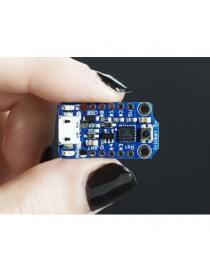Trinket may be small, but do not be fooled by its size! It's a tiny microcontroller board, built around the Atmel ATtiny85, a little chip with a lot of power. We wanted to design a microcontroller board that was small enough to fit into any project, and low cost enough to use without hesitation. Perfect for when you don't want to give up your expensive dev-board and you aren't willing to take apart the project you worked so hard to design. It's our lowest-cost arduino-IDE programmable board!
The Attiny85 is a fun processor because despite being so small, it has 8K of flash, and 5 I/O pins, including analog inputs and PWM 'analog' outputs. We designed a USB bootloader so you can plug it into any computer and reprogram it over a USB port just like an Arduino. In fact we even made some simple modifications to the Arduino IDE so that it works like a mini-Arduino board. You can't stack a big shield on it but for many small & simple projects the Trinket will be your go-to platform.
This is the 5V Trinket. There are two versions of the Trinket. One is 3V and one is 5V. Both work the same, but have different operating logic voltages. Use the 3V one to interface with sensors and devices that need 3V logic, or when you want to power it off of a LiPo battery. The 3V version should only run at 8 MHz. Use the 5V one for sensors and components that can use or require 5V logic. The 5V version can run at 8 MHz or at 16MHz by setting the software-set clock frequency.
Even though you can program Trinket using the Arduino IDE, it's not a fully 100% Arduino-compatible. There are some things you trade off for such a small and low cost microcontroller!
- Trinket does not have a Serial port connection for debugging so the serial port monitor will not be able to send/receive data
- Some computers' USB v3 ports don't recognize the Trinket's bootloader. Simply use a USB v2 port or a USB hub in between
Here are some useful specifications!
- ATtiny85 on-board, 8K of flash, 512 byte of SRAM, 512 bytes of EEPROM
- Internal oscillator runs at 8MHz, but can be doubled in software for 16MHz
- USB bootloader with a nice LED indicator looks just like a USBtinyISP so you can program it with AVRdude (with a simple config modification) and/or the Arduino IDE (with a few simple config modifications)
- Micro-USB jack for power and/or USB uploading, you can put it in a box or tape it up and use any USB cable for when you want to reprogram.
- We really worked hard on the bootloader process to make it rugged and foolproof, this board wont up and die on you in the middle of a project!
- ~5.25K bytes available for use (2.75K taken for the bootloader)
- Available in both 3V and 5V flavors
- On-board 3.3V or 5.0V power regulator with 150mA output capability and ultra-low dropout. Up to 16V input, reverse-polarity protection, thermal and current-limit protection.
- Power with either USB or external output (such as a battery) - it'll automatically switch over
- On-board green power LED and red pin #1 LED
- Reset button for entering the bootloader or restarting the program. No need to unplug/replug the board every time you want to reset or update!
- 5 GPIO - 2 shared with the USB interface. The 3 independent IO pins have 1 analog input and 2 PWM output as well. The 2 shared IO pins have 2 more analog inputs and one more PWM output.
- Hardware I2C / SPI capability for breakout & sensor interfacing.
- Works with many basic Arduino libraries including Adafruit Neopixel!
- Mounting holes! Yeah!
- Really really small
For a lot more details, including a tour of the Trinket, pinout details and Arduino IDE examples, check out the Introducing Trinket tutorial
-
Technical Details
-
Learn
Fashion headwear for cyberpunks, steampunks and Daft Punks.
Introducing Adafruit's mini microcontroller
I got rhythm! I got music!
Get your Trinket or Gemma moving
Make music with tiny microcontrollers and varying light levels
A simple cyberpunk/Tronpunk fashion project!
Use a Trinket or Gemma to determine the IR codes from your remote and use the codes in your own program to trigger events
Itsy bitsy electronic jewelry!
Turning the Trinket into a standard USB keyboard.
Monitor temperature and humidity on an LCD display with this compact Trinket-based project
Measure distances with the Maxbotix series ultrasonic range finders and the Trinket
Add sound reactive color to your tunes.
Making a volume control knob using the Trinket connected to your computer via USB.
Old School analog meters are used to create modern art timekeeping.
Add a USB serial port to your Trinket using software
Unlock a drawer by knocking a secret pattern.
This Trinket project is really quite hairy!
3D Printed Moravian Star + NeoPixel + Trinket Topper
A LED matrix project that displays when a room is occupied
Yes, Trinket can interface with several larger parts
Turn a 24x NeoPixel ring into a light for a DSLR camera
A simple clock using the NeoPixel 60 Ring
Eye Candy in Three Dimensions
Make your own Adabot Toy!




